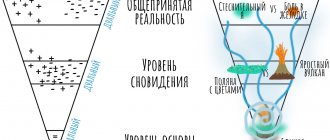Body-oriented psychotherapy is a way of getting rid of emotional experiences through interaction with the body. Everything we experience is reflected in our body. Negative and traumatic experiences are recorded in the body in the form of clamps and tensions.
A body therapist helps you pay attention to tense points in the body, and through them, identify the experiences that caused them. Having understood the reason, you can already work with it - learn to free yourself from the past and its constraining influence.
Thus, the goal of body therapy is to get rid of the influence of negative experiences experienced in the past on the present.
The founder of body therapy is Wilhelm Reich. He was a student of S. Freud, but concentrated his attention on studying the effects on the body. His work was continued by many scientists in different countries of the world. Today, body-oriented psychotherapy has many directions and continues to actively develop.
Advantages of the method:
- The main advantage of body-oriented psychotherapy is its high efficiency .
- This type of therapy allows you to interact with the unconscious. 90% of our subconscious manifests itself non-verbally, that is, not through speech, but through the body. Bodily clamps are a reflection of negative experiences, conflicts that have not received a way out and are “fixed” in the body.
- A bodily psychotherapist reads these signals, helps to reveal their causes, release negative emotions from the soul, and, as a result, free the body from clamps.
- Body psychotherapy can prevent the development of psychosomatic diseases , which are caused precisely by internal conflicts and negative experiences that have not received an outlet.
Sometimes tightness and lack of contact with one’s body reaches the point that a person loses the ability to grasp his true feelings. In this case, feelings are replaced by consciousness - it “tells” a person in which situation one should experience admiration, interest, sympathy, and in which - rejection. At the same time, a person’s true feelings may be completely different from those that consciousness imposes on him. Such a contradiction can cause serious internal conflict. Therefore, it is important to work with your body and respond to its silent signals.
Oksana Barkova, psychotherapist, Gestalt psychologist:
In my work, I always pay attention to the Body, since it is impossible to work through any emotional or psychological difficulty without removing the bodily block.
Any difficulty has an imprint on the body, creating a kind of physical and emotional “shell”, not allowing you to more fully experience and realize your emotions, distorting them.
The body remembers everything from the moment of birth: emotions, situations, memories, so through the body you can work with any human experience.
Working through muscle tension, which is the basis of psychological difficulty, allows you not only to solve the problem, but also to move on to correct bodily regulation and rely on the body’s resources. This is the main difference and advantage of body therapy over other psychotherapeutic methods.
The most popular cognitive psychotherapy techniques
Treatment of mental disorders using cognitive psychotherapy is not just a way to combat a specific disease. This approach to therapy gives the patient a special perspective on everything that happens in his life. Thus, it is possible to prevent the development of relapses and other mental disorders. A person trained in the basics of cognitive psychotherapy is able to systematically monitor his own negative emotions and transform them into rational thoughts. This method is especially effective in combating panic attacks.
All techniques used in cognitive psychotherapy can be divided into two large groups:
- techniques aimed at identifying automatic thoughts of a negative nature. The main way to achieve this goal is to interview the patient, but the therapist can also use role-playing techniques. After the automatic thought is found by the patient, the therapist must check it with behavioral factors, as well as logical analysis. In some cases, the identified beliefs turn out to be a mythologem, but most often such thoughts nevertheless take place in reality, although they are not realized by the patient. The therapist must identify the relationship between the automatic thought and the traumatic situation and pathological emotional reactions;
- techniques that allow you to identify the unreasonableness of an automatic thought and cognitively reconstruct it. A person will be able to abandon a maladaptive thought only if he is completely sure of its “wrongness.” First of all, the validity of such thinking can be verified by its consequences. This technique is called decatastrophizing or “what if.” The patient imagines the consequences of the situation that frightens him, and understands that in fact nothing terrible will happen. You can push a person to check irrational thoughts with real actions. If the patient suffers from depression, believing that he is not capable of anything, then he can be given small tasks. Their successful implementation will restore a person’s faith in his own strength. The psychotherapist can also invite the patient to compare his situation with another case from his practice. By feeling sorry for a patient with similar problems, the patient automatically feels sorry for himself. As a result, the negative attitude towards oneself changes into pity and sympathy. A similar result can be achieved using the catharsis method, when the therapist encourages the patient to speak out and cry. In addition, there are a large number of other methods that allow you to change cognitive attitudes.
Throughout the course of therapy, the patient receives homework. He must track automatic thoughts and record his feelings in a special notebook. A psychotherapist may recommend reading certain literature and listening to recordings of psychotherapy sessions.
Most often, psychotherapy is individual, but group work can also be used. In the latter case, not the relationships between its individual members are examined, but the rationality of their thinking and behavior is assessed.
In what cases will body therapy help?
This type of psychotherapy can be recommended in a number of cases, such as:
- severe stress (loss, divorce, separation and other life situations);
- conflicts in couples and in the family;
- difficulties in your career: difficulties in relationships with colleagues and superiors, inability to defend and defend your opinion, lack of satisfaction from work;
- constant bad mood, apathy, restless sleep, tearfulness, depression;
- loss of meaning in life;
- fear, obsessive anxious thoughts;
- aggression, irritability;
- frequent colds, long-term illnesses.
It is important to note that body-oriented psychotherapy is not a replacement for conservative or surgical treatment of diseases, but serves as its complement.
What is Cognitive Behavioral Therapy (CBT)
CBT is a complex psychotherapy based on human cognitive processes and behavior.
In practice, it has been used since the 60s of the last century. Its goal is to help a person work on negative thoughts and feelings in order to cope with mental problems.
In addition to addictions, CBT is used in the treatment of concomitant diseases:
- anxiety disorder;
- attention deficit disorder;
- bipolar disorder;
- obsessive-compulsive disorder;
- eating disorders;
- post-traumatic stress disorder.
Why is working with the body important?
A person experiences reality only through the body. When the connection between soul and body is broken, a person feels the world of his own experiences and illusions more realistically than the surrounding reality. As a result, the brightness and fullness of feelings and emotions is lost, nothing brings pleasure, and something is constantly missing in life. Some characterize this state as follows: “I live like a zombie,” “Like in a dream,” “Like frozen.”
In order to “return” to the real world again, to fully experience it, you must first free your body. Muscle “armor” makes it very difficult not only to enjoy life, but even to breathe and walk. Imagine that they put two sheepskin coats on you and put on heavy felt boots with galoshes. And you live 24 hours a day, even sleep, in such clothing. Now take and throw off this burden, remaining in light summer clothes. It's better, right? But no external conditions have changed, only your body has gotten rid of heaviness. Therefore, body-oriented therapy, working with muscle tension and returning the body to its original, harmonious state, helps solve psychological problems.
Comment from a SELF center specialist:
A man came for a consultation, his name was Ivan, 32 years old, with a request about his relationship with his wife - there had been an affair. During the meeting, the man, describing his situation, lowered his head down, breathed shallowly and periodically clenched his jaw. I drew his attention to how his body behaved when he described his difficulty. It turned out that for several months now his right shoulder has been hurting, constantly, nothing helps, the pain radiates to the shoulder blade and spreads along the spine.
We began to explore this pain and its connection with what the man was experiencing and thinking.
– What word is associated with pain?
- Sharp, sharp, furious.
At the same time, Ivan began to clench and unclench his fists, his breathing became more “heavy.”
“What emotion is asking to be noticed?” – I asked. The man, restraining himself, replied that it was anger, rage, a desire to break something and hit someone.
Then I asked: “What are these emotions trying to protect, what feeling or image?” The man answered with tears in his eyes that this was powerlessness, despair and the inability to return to his previous relationship with his wife.
After these words and allowing himself to be with the feelings of sadness, powerlessness, anger, despair, he was surprised to notice that the muscles relaxed and the pain went away. The emotional tension created by this feeling affected the muscles, causing them to spasm, blocking natural movement. And they immediately relaxed as soon as the emotion was identified and lived.
Body-oriented therapy techniques:
There are different methods of body therapy:
- massage,
- breath,
- various exercises that can be done standing, sitting, lying down.
The purpose of the techniques is not to “fix” the body. They are aimed, first of all, at realizing the body and restoring connection with it.
Often a “side effect” of body-oriented therapy is an improved figure.
The fact is that drooping shoulders, incorrect posture, and sunken chests are often associated not with poor physical fitness, but with psychological problems. Unfulfilled desires, driven-in fears, complexes, worries, emotions that cannot find a way out accumulate in our body, causing it to bend and become ossified. When negative energy is released during therapy, the body straightens, becomes flexible and relaxed.
How do body therapy sessions work?
The first task of a body therapist is to determine what internal problems prevent you from fully enjoying life and freely controlling your body. To do this, he identifies a problem area - an area of the body where the muscles are constantly and unnaturally tense, and there is pain. This is an indicator that allows you to understand what is troubling a person - after all, this is the reason that caused the muscle tension. When it is possible to determine the cause, a physical psychologist offers special exercises that help to re-experience the condition that caused stress in order to let it go forever. A sign that the old problem has really been released will be the body - it will relax, getting rid of tensions.
Physical contact during communication between the therapist and the patient is not necessary - its presence or absence depends on the wishes of the patient. The work can also be done verbally, without touching.
It is worth noting that touch has a high psychotherapeutic effect, but only if the patient is disposed to this form of communication with the therapist.
Humanistic and existential direction
Humanistic psychology believes that every person has a natural need for development and self-realization, and problems arise if something interferes with it. A specialist working with this technique offers empathy, understanding and a joint search for life values as help.
The humanistic school is very heterogeneous. In fact, this is a “hodgepodge” of methods that cannot be attributed either to cognitivism or psychoanalysis.
Client-centered therapy
Carl Rogers was the first to suggest that each person’s experience be considered valuable and unique, seek an individual approach and communicate as equals. At his instigation, the term “patient” (that is, sick) in psychotherapy was replaced by “client” (that is, an equal partner). Such psychotherapy presupposes an independent opportunity for a person to understand what is best for him, and the therapist must only create conditions of acceptance and support for finding a path to himself.
Logotherapy, or therapy with meaning
Another well-known direction was proposed by Viktor Frankl, a psychologist who survived imprisonment in a concentration camp. Frankl was sure that a meaningful life for man as a thinking creature is more important than basic instincts, and, unlike animals, man is always free to choose. Logotherapy takes place in the format of philosophical conversations and invites the client to understand the meaning of their life and take responsibility for it.
Gestalt therapy
It was created by Frederick Perls and also belongs to the humanistic movement. This therapy teaches you to live in the here and now and listen to your emotions, which many people are unaware of or suppress. The therapist helps the client become more attentive to himself, understand his experiences and resolve internal conflicts. This is not the most popular type of psychotherapy in other countries and not the most effective. But in Russia it has become widespread, probably due to the activity of Gestalt institutes and the relative ease of learning.
Existential analysis . Existential psychology believes that suffering and crises in life are inevitable, moreover, they are necessary for development. Everyone faces death, loneliness, inner emptiness and the need to choose. The therapist's job is to help the client understand and accept this experience.
Advantages of humanistic therapy: Support, creative search for solutions, communication with a psychotherapist as equals.
Disadvantages of humanistic therapy: Lack of ready-made recipes and methods for solving the problem.
How to choose a body therapist?
To choose “your” body therapist, pay attention to the following points:
- Techniques used by the specialist. Everyone has their own preferred techniques of body-oriented psychotherapy. Some people work with breathing, others use massage. Choose a therapist who knows the technique that will be comfortable for you.
- Where do therapy sessions take place? It is important that the room is cozy, that it has a comfortable temperature, good, but not too bright lighting. These are necessary conditions in order to relax and concentrate on your feelings.
- Subjective impressions. The specialist you will work with should evoke positive emotions in you. Don’t try to analyze your feelings - just feel whether you want to go to this therapist or not. A positive attitude is the basis for building the trust that is necessary for effective therapy.
What misconceptions does cognitive behavioral therapy work with?
- The addict thinks about approval from others, but not often about family problems and the interests of family members.
- He is hostile and distrustful of others and does not expect anything good from them. There's a catch waiting. In severe cases, persecution mania and phobias are observed.
- Blames not himself, but other people or circumstances. For example, “it was inconvenient to refuse drinking at a corporate party.”
- He thinks that it is easier to avoid life situations than to be responsible for the decisions made later. He is an outside observer and does not take any action to improve his life.
- Believes in the power of the past. Lives in regrets about himself and his behavior. Therefore, at the beginning of treatment, the patient is afraid of further social life: what if everything will be bad with her because he is a former drug addict?










